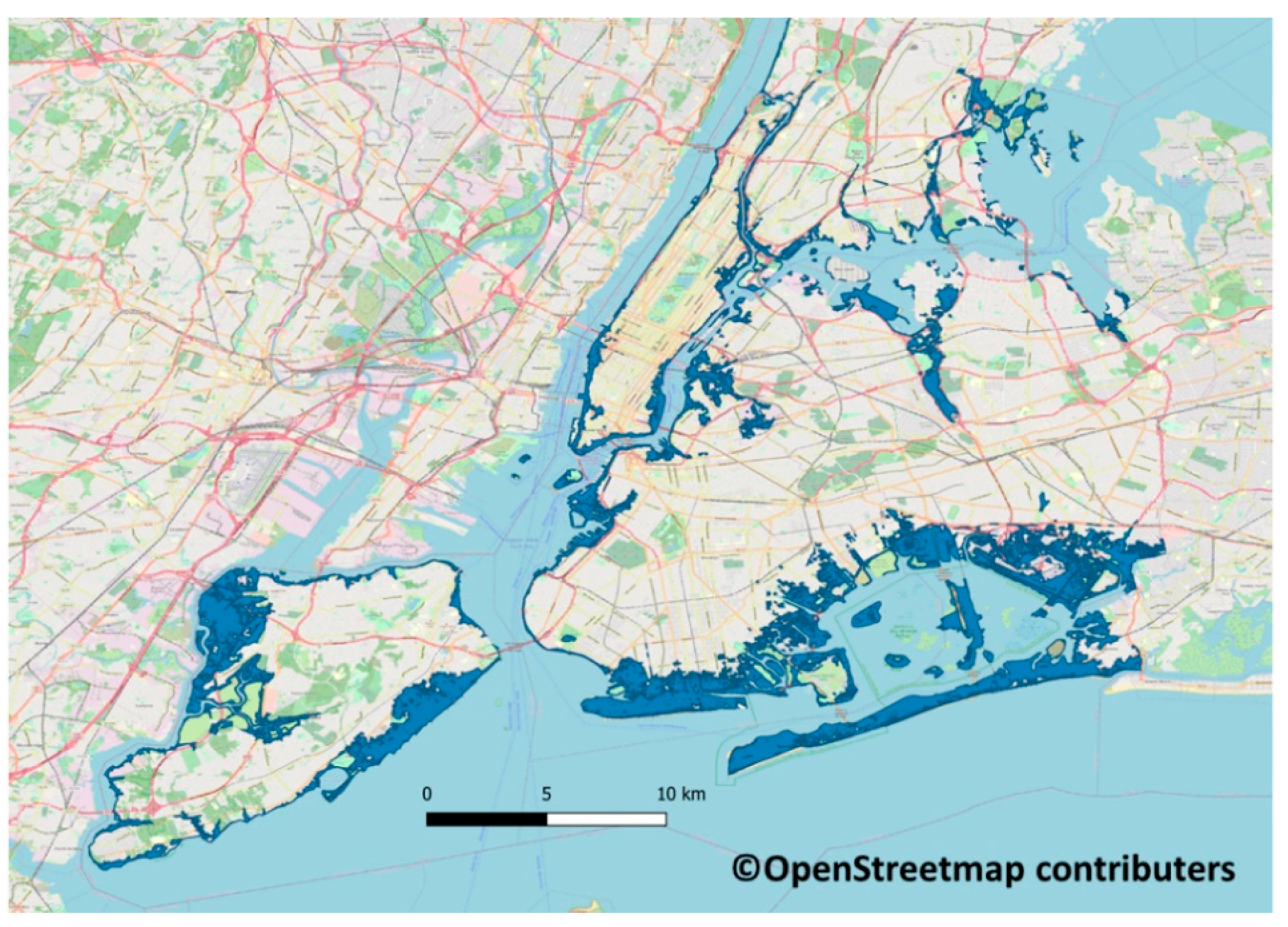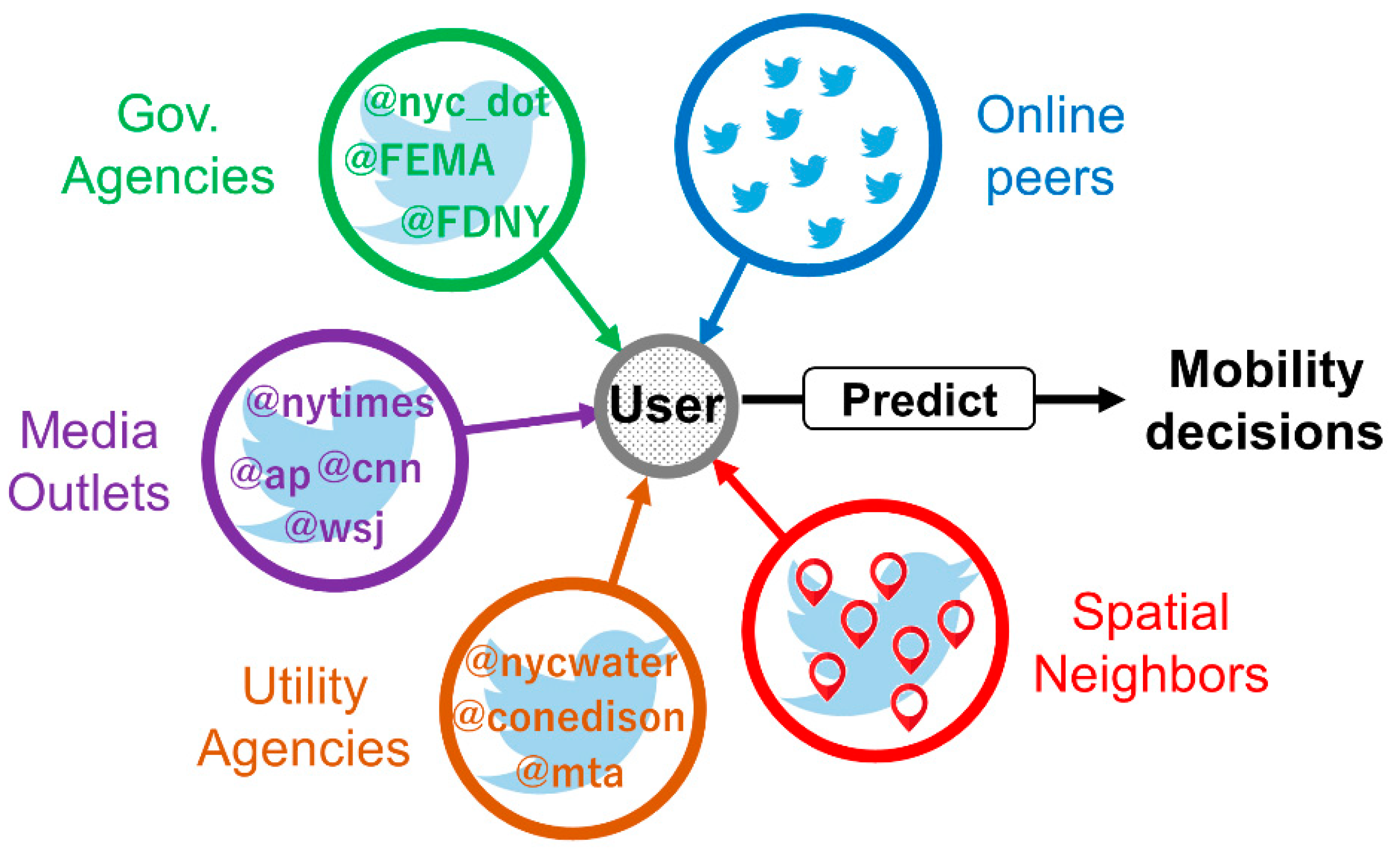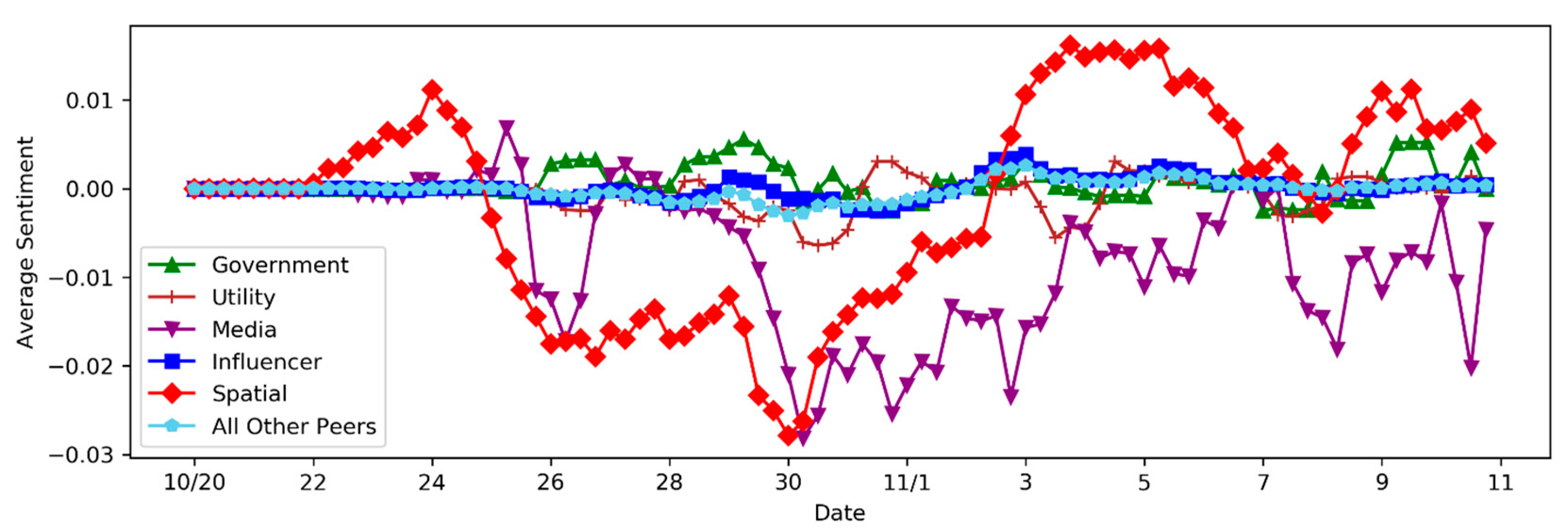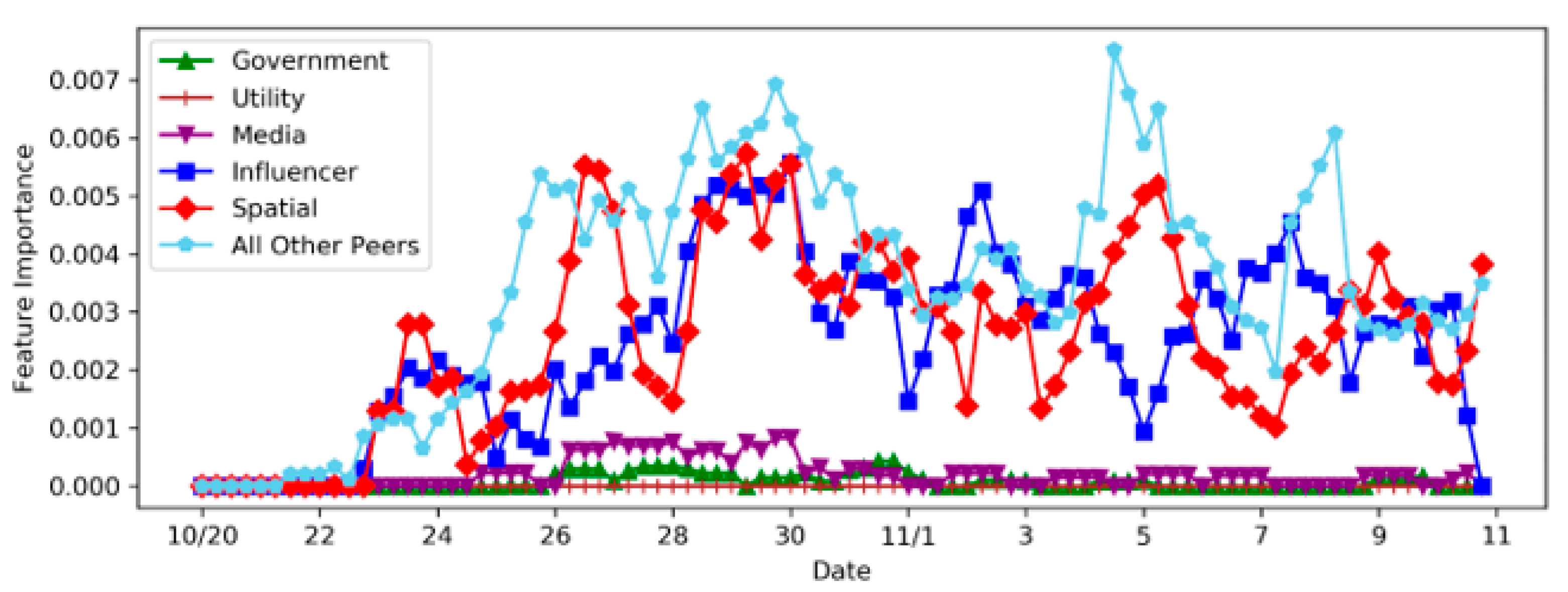Modeling the Influence of Online Social Media Information on Post-Disaster Mobility Decisions
Abstract
1. Introduction
2. Literature Review
3. Materials and Methods
3.1. Data
3.1.1. Hurricane Sandy
3.1.2. Twitter Data
3.1.3. Geographical Information Related to Hurricane Sandy
3.2. Overview of the Methodology
3.3. Analysis of Tweets and User Profiles
3.4. Ground Truth Labels for Post-Disaster Mobility Decisions
3.5. Classification Models
3.6. Evaluation Metrics
4. Results
4.1. Analysis of Twitter Data
4.2. Predictive Accuracy of Post-Disaster Mobility
5. Discussion
6. Conclusions
Author Contributions
Funding
Institutional Review Board Statement
Informed Consent Statement
Data Availability Statement
Acknowledgments
Conflicts of Interest
References
- Guo, J.; Liu, H.; Wu, X.; Gu, J.; Song, S.; Tang, Y. Natural Disasters, Economic Growth and Sustainable Development in China—An Empirical Study Using Provincial Panel Data. Sustainability 2015, 7, 16783–16800. [Google Scholar] [CrossRef]
- Bendimerad, F. Disaster risk reduction and sustainable development. In Proceedings of the World Bank Seminar on the Role of Local Governments in Reducing the Risk of Disasters, Istanbul, Turkey, 28 April 2003; Volume 28, pp. 57–75. [Google Scholar]
- McBean, G.A. Integrating disaster risk reduction towards sustainable development. Curr. Opin. Environ. Sustain. 2012, 4, 122–127. [Google Scholar] [CrossRef]
- UNISDR. Hyogo framework for action 2005–2015: Building the resilience of nations and communities to disasters. In Extract from the Final Report of the World Conference on Disaster Reduction (A/CONF. 206/6); The United Nations International Strategy for Disaster Reduction: Geneva, Switzerland, 2005; Volume 380. [Google Scholar]
- Baker, E.J. Hurricane evacuation behavior. Int. J. Mass Emergencies Disasters 1991, 9, 287–310. [Google Scholar]
- Fischer, H.W.; Stine, G.F.; Stoker, B.L.; Trowbridge, M.L.; Drain, E.M. Evacuation behavior: Why do some evacuate, while others do not? A case study of the Ephrata, Pennsylvania (USA) evacuation. Disaster Prev. Manag. Int. J. 1995, 4, 30–36. [Google Scholar] [CrossRef]
- Murray-Tuite, P.; Wolshon, B. Evacuation transportation modeling: An overview of research, development, and practice. Transp. Res. C Emerg. Technol. 2013, 27, 25–45. [Google Scholar] [CrossRef]
- Lindell, M.K.; Lu, J.C.; Prater, C.S. Household decision making and evacuation in response to Hurricane Lili. Nat. Hazards Rev. 2005, 6, 171–179. [Google Scholar] [CrossRef]
- Whitehead, J.C.; Edwards, B.; Van Willigen, M.; Maiolo, J.R.; Wilson, K.; Smith, K.T. Heading for higher ground: Factors affecting real and hypothetical hurricane evacuation behavior. Glob. Environ. Chang. B: Environ. Hazards 2000, 2, 133–142. [Google Scholar] [CrossRef]
- Dash, N.; Gladwin, H. Evacuation Decision Making and Behavioral Responses: Individual and Household. Nat. Hazards Rev. 2007, 8, 69–77. [Google Scholar] [CrossRef]
- Forrest, T.R.; Peacock, W.G.; Morrow, B.H.; Gladwin, H. Hurricane Andrew: Ethnicity, Gender and the Sociology of Disasters. Contemp. Sociol. A J. Rev. 1999, 28, 328. [Google Scholar] [CrossRef]
- Lovreglio, R.; Ronchi, E.; Nilsson, D. An Evacuation Decision Model based on perceived risk, social influence and behavioural uncertainty. Simul. Model. Pr. Theory 2016, 66, 226–242. [Google Scholar] [CrossRef]
- Gladwin, H.; Lazo, J.K.; Morrow, B.H.; Peacock, W.G.; Willoughby, H.E. Social Science Research Needs for the Hurricane Forecast and Warning System. Nat. Hazards Rev. 2007, 8, 87–95. [Google Scholar] [CrossRef][Green Version]
- Riad, J.K.; Norris, F.H.; Ruback, R.B. Predicting Evacuation in Two Major Disasters: Risk Perception, Social Influence, and Access to Resources1. J. Appl. Soc. Psychol. 1999, 29, 918–934. [Google Scholar] [CrossRef]
- Sadri, A.M.; Ukkusuri, S.V.; Gladwin, H. The Role of Social Networks and Information Sources on Hurricane Evacuation Decision Making. Nat. Hazards Rev. 2017, 18, 04017005. [Google Scholar] [CrossRef]
- Hasan, S.; Ukkusuri, S.V. A threshold model of social contagion process for evacuation decision making. Transp. Res. Part B Methodol. 2011, 45, 1590–1605. [Google Scholar] [CrossRef]
- Simon, T.; Goldberg, A.; Adini, B. Socializing in emergencies—A review of the use of social media in emergency situations. Int. J. Inf. Manag. 2015, 35, 609–619. [Google Scholar] [CrossRef]
- Martinez-Rojas, M.; del Carmen Pardo-Ferreira, M.; Rubio-Romero, J.C. Twitter as a tool for the management and analysis of emergency situations: A systematic literature review. Int. J. Inf. Manag. 2018, 43, 196–208. [Google Scholar] [CrossRef]
- Ceron, A.; Curini, L.; Iacus, S.M.; Porro, G. Every tweet counts? How sentiment analysis of social media can improve our knowledge of citizens’ political preferences with an application to Italy and France. New Media Soc. 2013, 16, 340–358. [Google Scholar] [CrossRef]
- Nguyen, T.H.; Shirai, K.; Velcin, J. Sentiment analysis on social media for stock movement prediction. Expert Syst. Appl. 2015, 42, 9603–9611. [Google Scholar] [CrossRef]
- Imran, M.; Elbassuoni, S.; Castillo, C.; Diaz, F.; Meier, P. Extracting information nuggets from disaster-related messages in social media. In Proceedings of the 15th International Conference on Information Systems for Crisis Response and Management (ISCRAM), Baden-Baden, Germany, 12–15 May 2013. [Google Scholar]
- Landwehr, P.M.; Carley, K.M. Social media in disaster relief. In Data Mining and Knowledge Discovery for Big Data; Springer: Berlin/Heidelberg, Germany, 2014; pp. 225–257. [Google Scholar]
- Fu, H.; Wilmot, C.G. Sequential Logit Dynamic Travel Demand Model for Hurricane Evacuation. Transp. Res. Rec. J. Transp. Res. Board 2004, 1882, 19–26. [Google Scholar] [CrossRef]
- Hasan, S.; Ukkusuri, S.; Gladwin, H.; Murray-Tuite, P. Behavioral model to understand household-level hurricane evacuation decision making. J. Transp. Eng. 2010, 137, 341–348. [Google Scholar] [CrossRef]
- Hasan, S.; Mesa-Arango, R.; Ukkusuri, S. A random-parameter hazard-based model to understand household evacuation timing behavior. Transp. Res. Part C Emerg. Technol. 2013, 27, 108–116. [Google Scholar] [CrossRef]
- Huang, S.-K.; Lindell, M.K.; Prater, C.S.; Wu, H.-C.; Siebeneck, L.K. Household Evacuation Decision Making in Response to Hurricane Ike. Nat. Hazards Rev. 2012, 13, 283–296. [Google Scholar] [CrossRef]
- Kaufman, H.F.; Clifford, R.A.; Killian, L.M.; Fritz, C.E.; Mathewson, J.H. The Rio Grande Flood: A Comparative Study of Border Communities in Disaster. Am. Sociol. Rev. 1958, 23, 102. [Google Scholar] [CrossRef]
- Yu, M.; Yang, C.; Li, Y. Big Data in Natural Disaster Management: A Review. Geosciences 2018, 8, 165. [Google Scholar] [CrossRef]
- Phengsuwan, J.; Shah, T.; Thekkummal, N.; Wen, Z.; Sun, R.; Pullarkatt, D.; Thirugnanam, H.; Ramesh, M.; Morgan, G.; James, P.; et al. Use of Social Media Data in Disaster Management: A Survey. Futur. Internet 2021, 13, 46. [Google Scholar] [CrossRef]
- Social Media Fact Sheet. Pew Research Center: Washington, DC, USA. Available online: http://www.pewinternet.org/fact-sheet/social-media/ (accessed on 1 December 2017).
- Kryvasheyeu, Y.; Chen, H.; Moro, E.; Van Hentenryck, P.; Cebrian, M. Performance of Social Network Sensors during Hurricane Sandy. PLoS ONE 2015, 10, e0117288. [Google Scholar] [CrossRef] [PubMed]
- Rashidi, T.H.; Abbasi, A.; Maghrebi, M.; Hasan, S.; Waller, T.S. Exploring the capacity of social media data for modelling travel behavior: Opportunities and challenges. Transp. Res. C Emerg. Technol. 2017, 75, 197–211. [Google Scholar] [CrossRef]
- Sakaki, T.; Okazaki, M.; Matsuo, Y. Earthquake shakes Twitter users. In Real-Time Event Detection by Social Sensors, Proceedings of the 19th International Conference on World Wide Web, ACM, Raleigh, NC, USA, 26–30 April 2010; Association for Computing Machinery: New York, NY, USA, 2010; pp. 851–860. [Google Scholar]
- Gu, Y.; Qian, Z.; Chen, F. From Twitter to detector: Real-time traffic incident detection using social media data. Transp. Res. Part C Emerg. Technol. 2016, 67, 321–342. [Google Scholar] [CrossRef]
- Sadri, A.M.; Hasan, S.; Ukkusuri, S.V.; Cebrian, M. Crisis Communication Patterns in Social Media during Hurricane Sandy. Transp. Res. Rec. J. Transp. Res. Board 2018, 2672, 125–137. [Google Scholar] [CrossRef]
- Kumar, D.; Yabe, T.; Ukkusuri, S.V. Social-Media aided Hyperlocal Help-Network Matching & Routing during Emergencies. In Proceedings of the 2018 IEEE International Conference on Big Data, Seattle, WA, USA, 10–13 December 2018; IEEE: New York, NY, USA, 2019; pp. 1606–1611. [Google Scholar]
- Kryvasheyeu, Y.; Chen, H.; Obradovich, N.; Moro, E.; Van Hentenryck, P.; Fowler, J.; Cebrian, M. Rapid assessment of disaster damage using social media activity. Sci. Adv. 2016, 2, e1500779. [Google Scholar] [CrossRef]
- Zamarreño-Aramendia, G.; Cristòfol, F.J.; De-San-Eugenio-Vela, J.; Ginesta, X. Social-Media Analysis for Disaster Prevention: Forest Fire in Artenara and Valleseco, Canary Islands. J. Open Innov. Technol. Mark. Complex. 2020, 6, 169. [Google Scholar] [CrossRef]
- Yabe, T.; Ukkusuri, S.V. Integrating information from heterogeneous networks on social media to predict post-disaster returning behavior. J. Comput. Sci. 2019, 32, 12–20. [Google Scholar] [CrossRef]
- Blake, E.S.; Kimberlain, T.B.; Berg, R.J.; Cangialosi, J.P.; Beven Ii, J.L. Tropical cyclone report: Hurricane sandy. Natl. Hurric. Cent. 2013, 12, 1–10. [Google Scholar]
- Kryvasheyeu, Y.; Chen, H.; Moro, E.; Van Hentenryck, P.; Cebrian, M. Data from: Performance of social network sensors during Hurricane Sandy. Dryad Digit. Repos. 2015, 31. [Google Scholar] [CrossRef]
- Thelwall, M.; Buckley, K.; Paltoglou, G.; Cai, D.; Kappas, A. Sentiment strength detection in short informal text. J. Am. Soc. Inf. Sci. Technol. 2010, 61, 2544–2558. [Google Scholar] [CrossRef]
- Signorini, A.; Segre, A.M.; Polgreen, P.M. The Use of Twitter to Track Levels of Disease Activity and Public Concern in the U.S. during the Influenza A H1N1 Pandemic. PLoS ONE 2011, 6, e19467. [Google Scholar] [CrossRef]
- Friedman, J.H. Stochastic gradient boosting. Comput. Stat. Data Anal. 2002, 38, 367–378. [Google Scholar] [CrossRef]
- Kipf, T.N.; Welling, M. Semi-Supervised Classification with Graph Convolutional Networks. In Proceedings of the 2017 International Conference on Learning Representations (ICLR), Toulon, France, 24–26 April 2017. [Google Scholar]
- Defferrard, M.; Bresson, X.; Vandergheynst, P. Convolutional neural networks on graphs with fast localized spectral filtering. In Proceedings of the Neural Information Processing Systems 2016, Barcelona, Spain, 5–10 December 2016; pp. 3844–3852. [Google Scholar]
- Han, Y.; Wang, S.; Ren, Y.; Wang, C.; Gao, P.; Chen, G. Predicting Station-Level Short-Term Passenger Flow in a Citywide Metro Network Using Spatiotemporal Graph Convolutional Neural Networks. ISPRS Int. J. Geo-Inf. 2019, 8, 243. [Google Scholar] [CrossRef]
- Lin, L.; He, Z.; Peeta, S. Predicting station-level hourly demand in a large-scale bike-sharing network: A graph convolutional neural network approach. Transp. Res. Part C Emerg. Technol. 2018, 97, 258–276. [Google Scholar] [CrossRef]
- Veličković, P.; Cucurull, G.; Casanova, A.; Romero, A.; Lio, P.; Bengio, Y. Graph attention networks. arXiv preprint arXiv:1710.10903, 2017. In Proceedings of the ICLR 2018, Vancouver, BC, Canada, 30 April–3 May 2018. [Google Scholar]
- Song, W.; Xiao, Z.; Wang, Y.; Charlin, L.; Zhang, M.; Tang, J. Session-based Social Recommendation via Dynamic Graph Attention Networks. In Proceedings of the Twelfth ACM International Conference on Web Search and Data Mining, ACM, Melbourne, Australia, 11–15 February 2019; pp. 555–563. [Google Scholar]
- Qiu, J.; Tang, J.; Ma, H.; Dong, Y.; Wang, K.; Tang, J. Deepinf: Social influence prediction with deep learning. In Proceedings of the 24th ACM SIGKDD International Conference on Knowledge Discovery & Data Mining, ACM, London, UK, 19–23 August 2018; pp. 2110–2119. [Google Scholar]
- Sadri, A.M.; Ukkusuri, S.V.; Murray-Tuite, P. A random parameter ordered probit model to understand the mobilization time during hurricane evacuation. Transp. Res. Part C Emerg. Technol. 2013, 32, 21–30. [Google Scholar] [CrossRef]
- Mikolov, T.; Sutskever, I.; Chen, K.; Corrado, G.S.; Dean, J. Distributed representations of words and phrases and their compositionality. In Proceedings of the Neural Information Processing Systems, NIPS 2013, Lake Tahoe, CA, USA, 5–10 December 2013; pp. 3111–3119. [Google Scholar]






| Account Category | Users Included |
|---|---|
| Government Agencies | @BarackObama, @fema, @femaregion2, @nws, @nwsnhc, @fdny, @mikebloomberg, @nycmayorsoffice, @nycoem, @notifynyc, @nycgov, @nycgovcuomo, @nycsanitation, @nyc_dot |
| Media Outlets | @nytimes, @cnn, @cnnbrk, @washingtonpost, @bbcbreaking, @wsj, @reuters, @theeconomist, @ap, @cnnweather, @outfrontcnn, @cnnlive, @cnnireport |
| Utility Agencies | @conedison, @nyc_buildings, @mta, @nyctsubway, @nycwater, @nationalgridus |
| Spatial Neighbors | Users estimated to be tweeting within 1 km of the target user’s location |
| Influencers | All users connected to the target user with more than 10,000 followers |
| Online Peers | All users connected to the target user |
| Feature Category | Feature Type | Description |
|---|---|---|
| Evacuation mobility characteristics | Evacuation Distance | Distance traveled during evacuation |
| Evacuation Time | Timing of evacuation | |
| Flood zone | Whether or not he/she was in flood zone | |
| Evacuation zone | Whether or not he/she was in evacuation zone | |
| Own tweets | User’s own tweets | Sentiment time series of user’s own tweets |
| Information from user’s online network | Online Friends | Sentiment time series of online friends |
| Government Agencies | Sentiment time series of government agencies | |
| Utility Companies | Sentiment time series of utility companies | |
| Media Outlets | Sentiment time series of media outlets | |
| Influencers | Sentiment time series of influencers | |
| Spatial Neighbors | Sentiment time series of spatial neighbors |
| Model | Best Hyperparameter[s] | F1-Score | AUC |
|---|---|---|---|
| Gradient Boosting Tree | # of Trees = 100 Maximum Depth = 2 | 0.828 () | 0.760 ) |
| Graph Attention Network | # of Attention Heads = 8 # Hidden Units = 8 | 0.761 () | 0.543 () |
| Logistic Regression | C = 1 Penalty = L1 | 0.678 () | 0.634 () |
| Support Vector Classifier | C = 0.1 Kernel = rbf | 0.711 () | 0.563 () |
| K-Nearest Neighbor | K = 3 | 0.604 () | 0.539 () |
| Mobility | Own Tweets | Information from Online Network | F1-Score | AUC |
|---|---|---|---|---|
| - | - | 0.807 () | 0.702 () | |
| ✓ | ✓ | - | 0.814 ( | 0.744 () |
| ✓ | ✓ | ✓ | 0.828 () | 0.760 () |
Publisher’s Note: MDPI stays neutral with regard to jurisdictional claims in published maps and institutional affiliations. |
© 2021 by the authors. Licensee MDPI, Basel, Switzerland. This article is an open access article distributed under the terms and conditions of the Creative Commons Attribution (CC BY) license (https://creativecommons.org/licenses/by/4.0/).
Share and Cite
Yabe, T.; Rao, P.S.C.; Ukkusuri, S.V. Modeling the Influence of Online Social Media Information on Post-Disaster Mobility Decisions. Sustainability 2021, 13, 5254. https://doi.org/10.3390/su13095254
Yabe T, Rao PSC, Ukkusuri SV. Modeling the Influence of Online Social Media Information on Post-Disaster Mobility Decisions. Sustainability. 2021; 13(9):5254. https://doi.org/10.3390/su13095254
Chicago/Turabian StyleYabe, Takahiro, P. Suresh C. Rao, and Satish V. Ukkusuri. 2021. "Modeling the Influence of Online Social Media Information on Post-Disaster Mobility Decisions" Sustainability 13, no. 9: 5254. https://doi.org/10.3390/su13095254
APA StyleYabe, T., Rao, P. S. C., & Ukkusuri, S. V. (2021). Modeling the Influence of Online Social Media Information on Post-Disaster Mobility Decisions. Sustainability, 13(9), 5254. https://doi.org/10.3390/su13095254






